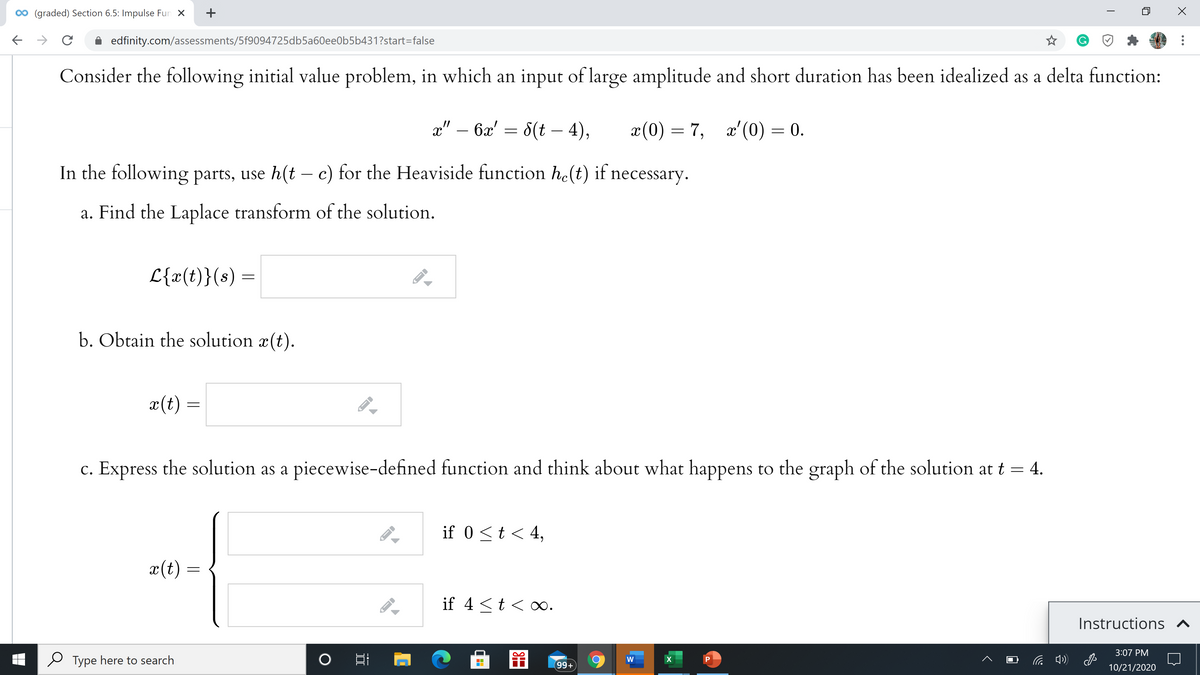Consider the following initial value problem, in which an input of large amplitude and short duration has been idealized as a delta function: æ" – 6x' = 8(t – 4), æ(0) = 7, x'(0) = 0. In the following parts, use h(t – c) for the Heaviside function he(t) if necessary. a. Find the Laplace transform of the solution. L{x(t)}(s) = b. Obtain the solution æ(t). x(t) = c. Express the solution as a piecewise-defined function and think about what happens to the graph of the solution at t = 4.
Consider the following initial value problem, in which an input of large amplitude and short duration has been idealized as a delta function: æ" – 6x' = 8(t – 4), æ(0) = 7, x'(0) = 0. In the following parts, use h(t – c) for the Heaviside function he(t) if necessary. a. Find the Laplace transform of the solution. L{x(t)}(s) = b. Obtain the solution æ(t). x(t) = c. Express the solution as a piecewise-defined function and think about what happens to the graph of the solution at t = 4.
Linear Algebra: A Modern Introduction
4th Edition
ISBN:9781285463247
Author:David Poole
Publisher:David Poole
Chapter4: Eigenvalues And Eigenvectors
Section4.6: Applications And The Perron-frobenius Theorem
Problem 70EQ
Related questions
Concept explainers
Contingency Table
A contingency table can be defined as the visual representation of the relationship between two or more categorical variables that can be evaluated and registered. It is a categorical version of the scatterplot, which is used to investigate the linear relationship between two variables. A contingency table is indeed a type of frequency distribution table that displays two variables at the same time.
Binomial Distribution
Binomial is an algebraic expression of the sum or the difference of two terms. Before knowing about binomial distribution, we must know about the binomial theorem.
Topic Video
Question
Problem 2

Transcribed Image Text:(graded) Section 6.5: Impulse Fun X
edfinity.com/assessments/5f9094725db5a60ee0b5b431?start=false
Consider the following initial value problem, in which an input of large amplitude and short duration has been idealized as a delta function:
a" – 6x' = 8(t – 4),
x(0) = 7, x'(0) = 0.
-
In the following parts, use h(t – c) for the Heaviside function he(t) if necessary.
a. Find the Laplace transform of the solution.
L{x(t)}(s) =
b. Obtain the solution x(t).
x(t) =
c. Express the solution as a piecewise-defined function and think about what happens to the graph of the solution at t = 4.
if 0 <t < 4,
x(t) =
if 4 <t < .
Instructions ^
3:07 PM
Type here to search
W
99+
10/21/2020
---
II
+
Expert Solution
This question has been solved!
Explore an expertly crafted, step-by-step solution for a thorough understanding of key concepts.
This is a popular solution!
Trending now
This is a popular solution!
Step by step
Solved in 4 steps

Knowledge Booster
Learn more about
Need a deep-dive on the concept behind this application? Look no further. Learn more about this topic, advanced-math and related others by exploring similar questions and additional content below.Recommended textbooks for you

Linear Algebra: A Modern Introduction
Algebra
ISBN:
9781285463247
Author:
David Poole
Publisher:
Cengage Learning

Trigonometry (MindTap Course List)
Trigonometry
ISBN:
9781337278461
Author:
Ron Larson
Publisher:
Cengage Learning

Linear Algebra: A Modern Introduction
Algebra
ISBN:
9781285463247
Author:
David Poole
Publisher:
Cengage Learning

Trigonometry (MindTap Course List)
Trigonometry
ISBN:
9781337278461
Author:
Ron Larson
Publisher:
Cengage Learning